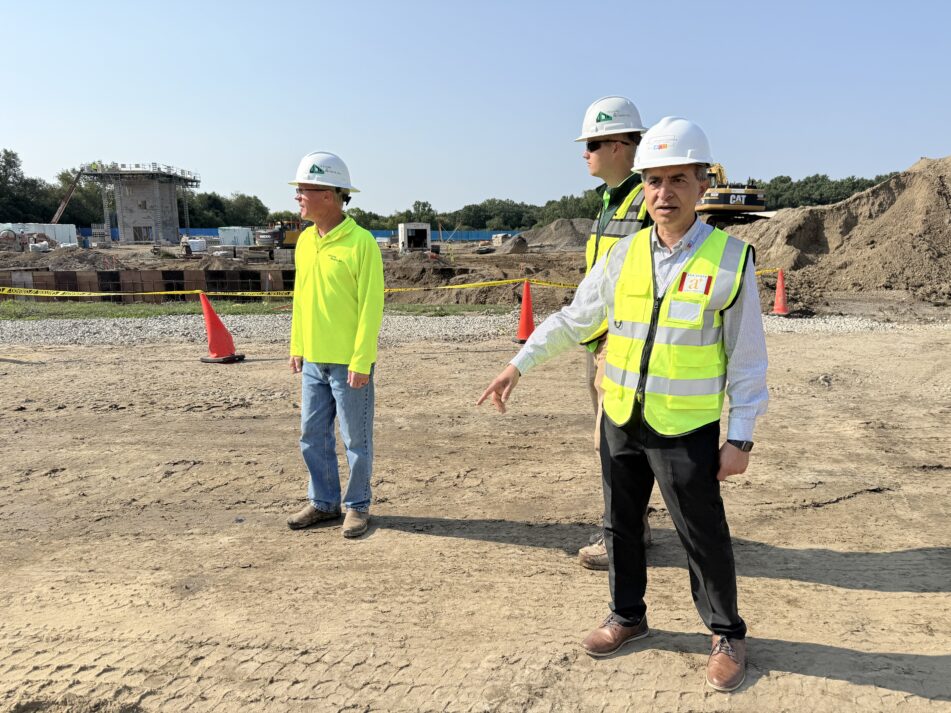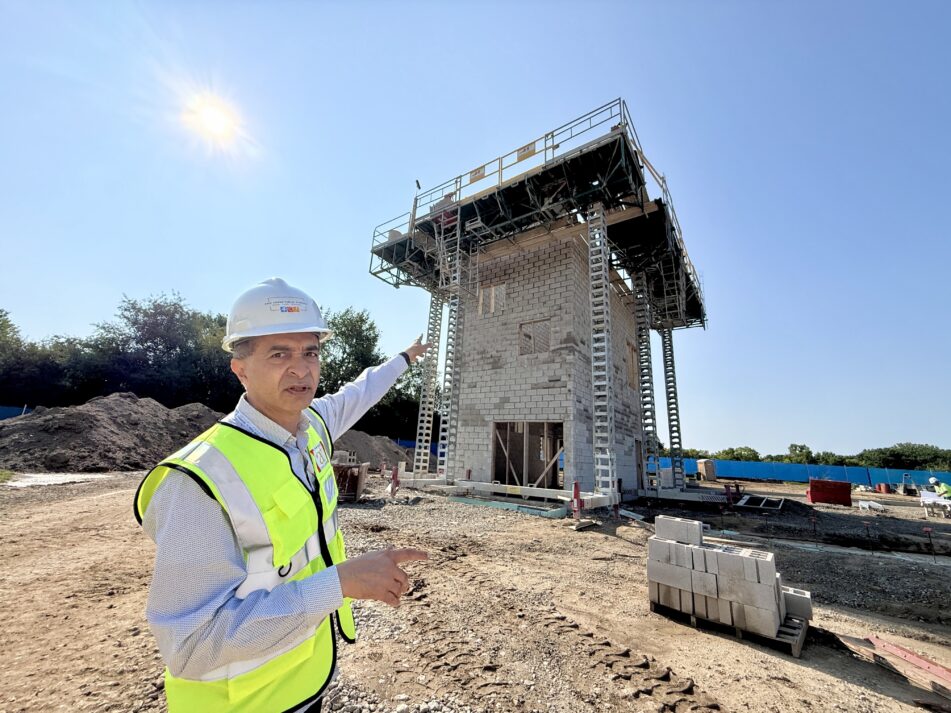

AAPS Capital Programs Manager Moe Nagpal moved to Ann Arbor from Houston with his family 22 years ago. His son, Sebastian, and daughter, Natalie, attended Ann Arbor Public Schools before continuing to the University of Michigan. His wife, Delia, is a longtime educator who teaches Spanish at two local private schools.
Nagpal holds a master’s degree in Engineering and Management and is certified in Non-Profit Management, Project Management, and as a Lean Six Sigma Black Belt. After a 25-year career in global positions with Fortune 100 companies, including GM, EDS, and HP, he decided to apply those skills to the social and non-profit sector. For about 10 years now, Nagpal has been working for organizations with missions beyond generating shareholder profits, finding fulfillment in community-benefiting roles. He joined AAPS two years ago.
Nagpal demonstrates exceptional strategic thinking with his ability to see the big picture and connect dots others miss, says Bernerd Rice, AAPS Assistant Superintendent, Capital Programs & Physical Properties.
“Moe embraces challenges and views setbacks as valuable learning opportunities, showing a true growth mindset,” says Rice. “He is a well-rounded professional who combines approachability with infectious enthusiasm and optimism. Since joining the team, his can-do attitude and positive energy have made a significant impact on both colleagues and district operations.”
What drew you to facilities management in the education sector?
As a proud parent to two Huron graduates, I supported the Ann Arbor Schools $1 Billion Bond proposal in 2019, and when the opportunity aligned with my availability and aspirations to contribute to the building of future-ready, energy-efficient, sustainable schools for students’ needs, I gladly accepted the generational challenge and opportunity.

What does a typical day look like for you as Physical Properties Manager, and how do you prioritize the various construction projects across the district?
Most days are packed with meetings with contractors, construction managers, program managers, and visits to the various projects. Meeting school principals and office professionals to communicate the plans, status, and completion timing of projects is a key element of the role. Major projects require collaboration with architects, engineers, and finance professionals to design and bid projects and then get them approved by the Board of Education. Sometimes there are unplanned events like power outages or equipment malfunctions that need attention and resolution as soon as possible. A large team of contractors is engaged by a small team of AAPS Physical Properties and Capital Program team members to address issues and work on new projects, maintain existing facilities, and address issues as they arise.
Ann Arbor Public Schools has undergone significant facility improvements in recent years. What are some of the major construction projects you’ve overseen, and what challenges did you navigate?
There are over a dozen schools undergoing renovations, rooftop solar PV installation, and energy efficiency upgrades to the building envelopes and HVAC equipment upgrades this summer alone. Additionally, this past spring, there were groundbreaking ceremonies for four new schools: Dicken, Logan, Mitchell, and Thurston, as well as a multi-year renovation planned at Slauson.
Several other elementary school rebuilds are included in Bond Phase 2 and are scheduled to begin within the next few years.
Needless to say, the sheer amount of work being handled by a very small staff of AAPS employees makes it quite a challenge. We have great support from Program Management and Construction Management contractors, as well as several architects and engineers, who will make these projects come to fruition. Market conditions with supply chain uncertainties and pricing increases have been a challenge recently.
It’s been an exceptionally hot summer. Has that impacted the projects?
The teams have been working through the summer heat, but it’s the rain and thunderstorms that usually stop or delay work, as it makes conditions unsafe for people to work. Summer is actually the busy time of the year as school is out, and that gives us about 2 months to get into schools (without students or teachers) to make the major modifications, add new climate control or solar equipment, or paint, replace floors, etc. It’s always a challenge to get all the work done by the week before students get back, and unexpected delays usually result in some parts of projects continuing into the Fall.

How do you balance the need for facility upgrades with minimizing disruption to students, teachers, and the learning environment?
Students, teachers, staff, and principals are our primary customers. We do our best to minimize any disruptions and, where there are issues, provide alternate options to ‘keep the lights on’. These could include bringing temporary equipment or creating spaces that allow student learning indoors and outdoors to continue. We do our best to inform all stakeholders of the plans, risks, and progress throughout the project, so everyone can be well informed of the challenges and participate in coming up with alternative solutions that will minimize disruption.
Can you describe a particularly complex construction project where your expertise made a significant difference in the outcome?
One of my favourite projects and quite complex implementation is the electrification of school buses. Unlike buying diesel buses, the process to get an electric bus ready to transport students is much more complex. This includes setting up charging infrastructure, which requires working with DTE to provision the electrical capacity, preparing the site to set up the chargers, and getting the buses to connect. This new technology also implies a change in the skillset needed to maintain and a small learning curve to drive them as efficiently as possible. Setting up charges that can charge any bus model, and also supporting Vehicle to Grid or Building (V2X) bi-directional battery setup has been a challenge. Using solar canopies to charge the buses is the next step in the journey. Each technology brings complexity in the setup and startup, but as we work out the issues, deployments in the future will be smoother. The best part is that this will enable us to transport students with minimal tailpipe emissions, so they can all breathe cleaner air while waiting at the bus stops and have a quiet, comfortable, and safe ride to school and back home.
What strategies do you use to manage multiple contractors, timelines, and budgets simultaneously across different school sites?
My approach to managing teams of contractors (and employees) can be summarized as Servant Leadership. It starts with leading by example, goal alignment, and steadfast focus on working as a team, supporting the teams in addressing challenges, learning from the mistakes, and building trusted relationships.
Practically, this requires:
- Regular communications with CM, PM, architects, and engineers
- Site visits to the locations
- Use of technology such as Procore or MS Project to manage the schedule, dependencies, and progress.

When unexpected issues arise during construction projects—whether it’s weather delays, supply chain problems, or unforeseen structural discoveries—how do you adapt and keep projects on track?
There are many twists and turns in projects, and in some cases, the delays are created by external uncontrollable factors like the weather, local permits, supply chain shortages, etc. We have an overall schedule, but the teams create a detailed plan for four weeks at a time. This time horizon is more predictable than two years. To make up for delays, we have contractors working longer hours, including over weekends, or adding more personnel where possible. Supply chain and pricing uncertainties are likely in this business environment and could lead to unforeseen challenges that will keep us all on our toes, to find ways to manage schedules and budgets.
How do you ensure that construction projects meet both current educational needs and anticipate future requirements for Ann Arbor’s growing student population?
Various experts are engaged in the process of sharing cutting-edge ideas, best practices, which are shared as part of the community, teachers, administrators, and student engagement process. Inputs from all stakeholders are carefully considered. Constraints such as cost and timing of the project are applied to come up with a future-ready solution.

Be the first to comment